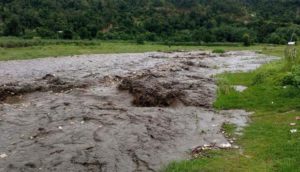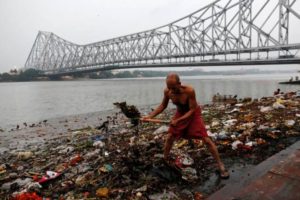Plastic waste flowing in Ashwani Khad
We often make plans for an escapade to the Himalayas, in the hope of witnessing its so-called pristine beauty and experience the calm that we so badly yearn for in our daily life’s hustle. But is there anything so truly pristine anymore? Almost all of the Himalayas has been thoroughly scoured, exploited and littered at the cost of seeing a natural beauty. Recently, a video showing heaps of trash flowing in the Ashwani Khad has gone viral on social media, once again ringing alarm bells about the issue of pollution of water bodies in Himachal Pradesh due to the absence of proper waste management system in the state. The video, which was taken by Healing Himalayas, has drawn the attention of the National Green Tribunal that has taken a suo motto notice of the issue and directed the Himachal Pollution Control board Chairman Member Secretary to send in a detail report on the issue at hand. This is worrying because when the water crisis hit Shimla in May this year, the government drew a long-term plan and decided to use the water from Ashwani Khad for drinking water supply in Shimla.
Unfortunately, this is just the tip of the iceberg. There are several stakeholders in this process, and we as educated and responsible citizens must do our best to ameliorate the effect, and not exacerbate it. The mighty Ganga, distinctly identifiable with India’s historical and religion-cultural heritage and home to one of the most fertile and densely populated regions in the world, has been left blemished with years of dumping human waste, industrial effluents and other pollutants wearing away its natural flow and pristine quality.
A recent study by the IIHMR University in 78 villages adjoining the Ganga observed that most of the population was poor and uneducated. At least 25% met their household water needs from uncovered wells while only 18% treated their water before consumption. About 395 were used to defecating in the open. Waterborne diseases were common. It observed that open defecation, cremation of dead bodies and disposal of solid and liquid waste were the primary causal factor of pollution in the river.
A man cleans garbage along the banks of the river Ganges in Kolkata
In 2011, the government had established the NMCG (National Mission for Clean Ganga) to implement policies to arrest environmental degradation of the Ganga river basin. This body was then transferred to the National Council for Rejuvenation, Protection and Management of River Ganga in 2016. The Ganga Action Plan, being initiated in phases, has the goal of bringing river water quality bathing class standards by reducing biochemical oxygen demand, dissolved oxygen demand and coliform concentrations. The authorities have adopted a five-tier structure at the national, state and district levels to take measures to prevent, control and mitigate environmental pollution of Ganga and ensure continues and adequate flow of water.
Rivers like the Ganga form the lifeline of entire cultures and communities and hence, as the government tries to do their bit, we too must spare no effort in bringing back this mighty river to its once glorious status. We may not realize it at this moment, but it is literally now or never. Let us not give way to our primitive propensities and be more responsible towards our mountains, and towards our rivers.
Picture Credits Hindustan Times & Financial Express



